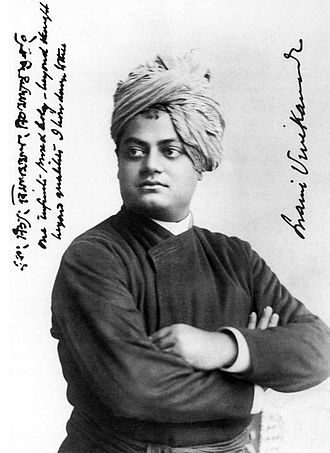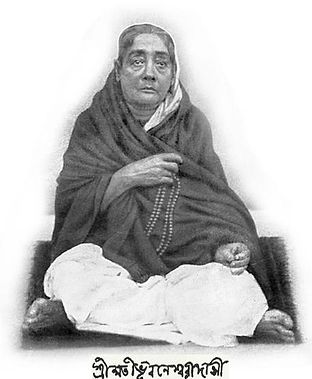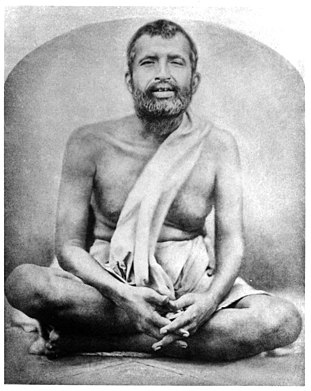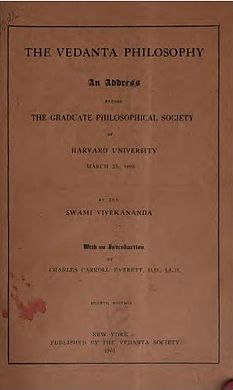Swami Vivekananda
Swami Vivekananda

Swami Vivekananda
Swami Vivekananda (12 January 1863 – 4 July 1902), born Narendranath Datta, was an Indian Hindu monk, a chief disciple of the 19th-century Indian mystic Ramakrishna. He was a key figure in the introduction of the Indian philosophies of Vedanta and Yoga to the Western world and is credited with raising interfaith awareness, bringing Hinduism to the status of a major world religion during the late 19th century. He was a major force in the revival of Hinduism in India, and contributed to the concept of Indian nationalism as a tool of fight against the British empire in colonial India. Vivekananda founded the Ramakrishna Math and the Ramakrishna Mission. He is perhaps best known for his speech which began with the words - "Sisters and brothers of America ...," in which he introduced Hinduism at the Parliament of the World's Religions in Chicago in 1893.
Born into an aristocratic Bengali Kayastha family of Calcutta, Vivekananda was inclined towards spirituality. He was influenced by his guru, Ramakrishna, from whom he learnt that all living beings were an embodiment of the divine self; therefore, service to God could be rendered by service to humankind. After Ramakrishna's death, Vivekananda toured the Indian subcontinent extensively and acquired first-hand knowledge of the conditions prevailing in British India. He later travelled to the United States, representing India at the 1893 Parliament of the World's Religions. Vivekananda conducted hundreds of public and private lectures and classes, disseminating tenets of Hindu philosophy in the United States, England and Europe. In India, Vivekananda is regarded as a patriotic saint, and his birthday is celebrated as National Youth Day.

Bhubaneswari Devi (1841–1911);
"I am indebted to my mother for the efflorescence of my knowledge." – Vivekananda
Birth and Childhood
Vivekananda was born Narendranath Datta (shortened to Narendra or Naren) in a Bengali family at his ancestral home at 3 Gourmohan Mukherjee Street in Calcutta, the capital of British India, on 12 January 1863 during the Makar Sankranti festival. He belonged to a traditional family and was one of nine siblings. His father, Vishwanath Datta, was an attorney at the Calcutta High Court. Durgacharan Datta, Narendra's grandfather was a Sanskrit and Persian scholar who left his family and became a monk at age twenty-five. His mother, Bhubaneswari Devi, was a devout housewife. The progressive, rational attitude of Narendra's father and the religious temperament of his mother helped shape his thinking and personality.
Narendranath was interested in spirituality from a young age and used to meditate before the images of deities such as Shiva, Rama, Sita, and Mahavir Hanuman. He was fascinated by wandering ascetics and monks. Naren was naughty and restless as a child, and his parents often had difficulty controlling him. His mother said, "I prayed to Shiva for a son and he has sent me one of his demons".

Ramakrishna, guru of Vivekananda
Education
In 1871, at the age of eight, Narendranath enrolled at Ishwar Chandra Vidyasagar's Metropolitan Institution, where he went to school until his family moved to Raipur in 1877. In 1879, after his family's return to Calcutta, he was the only student to receive first-division marks in the Presidency College entrance examination. He was an avid reader in a wide range of subjects, including philosophy, religion, history, social science, art and literature. He was also interested in Hindu scriptures, including the Vedas, the Upanishads, the Bhagavad Gita, the Ramayana, the Mahabharata and the Puranas. Narendra was trained in Indian classical music, and regularly participated in physical exercise, sports and organised activities. Narendra studied Western logic, Western philosophy and European history at the General Assembly's Institution (now known as the Scottish Church College). In 1881 he passed the Fine Arts examination, and completed a Bachelor of Arts degree in 1884. Narendra studied the works of David Hume, Immanuel Kant, Johann Gottlieb Fichte, Baruch Spinoza, Georg W. F. Hegel, Arthur Schopenhauer, Auguste Comte, John Stuart Mill and Charles Darwin. He became fascinated with the evolutionism of Herbert Spencer and corresponded with him, translating Spencer's book Education (1861) into Bengali. While studying Western philosophers, he also learned Sanskrit scriptures and Bengali literature.
William Hastie (principal of Christian College, Calcutta, from where Narendra graduated) wrote, "Narendra is really a genius. I have travelled far and wide but I have never come across a lad of his talents and possibilities, even in German universities, among philosophical students. He is bound to make his mark in life".
Narendra was known for his prodigious memory and the ability at speed reading. Several incidents have been given as examples. In a talk, he once quoted verbatim, two or three pages from Pickwick Papers. Another incident that is given is his argument with a Swedish national where he gave reference to some details on Swedish history that the Swede originally disagreed with but later conceded. In another incident with Dr. Paul Deussen's at Kiel in Germany, Vivekananda was going over some poetical work and did not reply when the professor spoke to him. Later, he apologised to Dr. Deussen explaining that he was too absorbed in reading and hence did not hear him. The professor was not satisfied with this explanation but Vivekananda quoted and interpreted verses from the text leaving the professor dumbfounded about his feat of memory. Once, he requested some books written by Sir John Lubbock from a library and returned them the very next day claiming that he had read them. The librarian refused to believe him until cross examination about the contents convinced him that Vivekananda was being truthful.
Some accounts have called Narendra a shrutidhara (a person with a prodigious memory).

Vedanta Philosophy An address before the Graduate Philosophical Society 1901 cover page
Works
Lectures
Although Vivekananda was a powerful orator and writer in English and Bengali, he was not a thorough scholar, and most of his published works were compiled from lectures given around the world which were "mainly delivered [...] impromptu and with little preparation". His main work, Raja Yoga, consists of talks he delivered in New York.
Literary works
According to Banhatti, "a singer, a painter, a wonderful master of language and a poet, Vivekananda was a complete artist", composing many songs and poems, including his favourite, "Kali the Mother". Vivekananda blended humour with his teachings, and his language was lucid. His Bengali writings testify to his belief that words (spoken or written) should clarify ideas, rather than demonstrating the speaker (or writer's) knowledge.
Bartaman Bharat meaning "Present Day India" is an erudite Bengali language essay written by him, which was first published in the March 1899 issue of Udbodhan, the only Bengali language magazine of Ramakrishna Math and Ramakrishna Mission. The essay was reprinted as a book in 1905 and later compiled into the fourth volume of The Complete Works of Swami Vivekananda. In this essay his refrain to the readers was to honour and treat every Indian as a brother irrespective of whether he was born poor or in lower caste.
Publications
Sangeet Kalpataru (1887, with Vaishnav Charan Basak)
Karma Yoga (1896)
Raja Yoga (1896 [1899 edition])
Vedanta Philosophy: An address before the Graduate Philosophical Society (1896)
Lectures from Colombo to Almora (1897)
Bartaman Bharat (in Bengali) (March 1899), Udbodhan
My Master (1901), The Baker and Taylor Company, New York
Vedânta philosophy: lectures on Jnâna Yoga (1902)
Jnana yoga (1899)
Published posthumously
Here is a list of selected books by Vivekananda that were published after his death (1902)
Addresses on Bhakti Yoga
Bhakti Yoga
The East and the West (1909)
Inspired Talks (1909)
Narada Bhakti Sutras – translation
Para Bhakti or Supreme Devotion
Practical Vedanta
Speeches and writings of Swami Vivekananda; a comprehensive collection
Death
On 4 July 1902 (the day of his death) Vivekananda awoke early, went to the monastery at Belur Math and meditated for three hours. He taught Shukla-Yajur-Veda, Sanskrit grammar and the philosophy of yoga to pupils, later discussing with colleagues a planned Vedic college in the Ramakrishna Math. At 7:00 pm. Vivekananda went to his room, asking not to be disturbed; he died at 9:20 p.m. while meditating. According to his disciples, Vivekananda attained mahasamādhi; the rupture of a blood vessel in his brain was reported as a possible cause of death. His disciples believed that the rupture was due to his brahmarandhra (an opening in the crown of his head) being pierced when he attained mahasamādhi. Vivekananda fulfilled his prophecy that he would not live forty years. He was cremated on a sandalwood funeral pyre on the bank of the Ganga in Belur, opposite where Ramakrishna was cremated sixteen years earlier.





